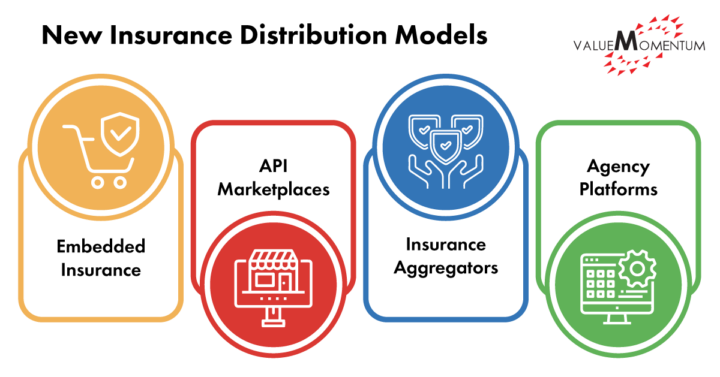Insurance carriers today face a unique challenge. They need to meet evolving customer demands for enhanced digital experiences while retaining the value of traditional sales channels and relationships made through brokers and agents. Whether carriers are connecting to customers directly, through InsurTechs, or through agents, they need to leverage all possible channels to expand access points for new customers and retain relevance in the continuously evolving insurance ecosystem.
Four key distribution models that can help insurers drive growth are: embedded insurance, API marketplaces, insurance aggregators, and agency channels. Insurers can capitalize on these new insurance distribution models while optimizing existing channels by leveraging the power of application programming interfaces (APIs). APIs support distribution expansion by allowing insurers to:
- integrate with partners and third parties,
- improve customer experience,
- enable expansion possibilities into new sales channels and market segments.
Leveraging New Insurance Distribution Models

Embedded Insurance
Embedded insurance bundles an insurance offering together with the purchase of a product or a service in real-time at the point of sale. At checkout, in a store or online, shoppers are offered insurance coverage for what they’ve put in their carts. This offering identifies a potential need for customers in a buying journey separate from traditional channels; it allows customers to include the insurance option as a seamless add-on from the seller to protect what they’re buying.
Embedded insurance is not only offered for big ticket items like flight reservations, furniture, appliances, and electronics; carriers have extended them to everyday products, many priced under $40. Growing partnerships between InsurTechs, carriers, and businesses have further enabled this expansion. For example, Airbnb is partnering with Zurich Insurance to offer host liability insurance through AirCover when people sign up to offer their accommodations through the Airbnb platform.
By partnering with third-party providers and integrating data with these businesses, insurers not only gain access to new customers with a new digital touchpoint, they are also able to launch highly specialized products and offer the products when consumers need the coverage the most.
API Marketplaces
API marketplaces provide agents access to multiple carriers through a unified API for quoting and submission capabilities, making it possible for agents to gain access to all their insurance needs under one (virtual) roof. Advanced digital integration enables the marketplace to get the code from multiple carriers and relay responses in near real-time.
Unlike other distribution models, API marketplaces do not have any user interface (UI) or web application for agents or customers to interact with each other directly. The marketplace simply brings together the APIs that the carriers expose to gain access to this distribution channel.
Herald is an example of such marketplace. Herald’s platform enables insurers to cut down the time it takes to connect to the insurance ecosystem from months to mere minutes. Participating carriers gain exposure to multiple distribution partners on the marketplace and can potentially reach many more agents and agencies than they ever could through traditional channels. For insurers with proper API capabilities, marketplaces offer accelerated speed-to-market and access to many distribution partners without a complicated onboarding process.
Insurance Aggregators
Insurance aggregators bring together multiple carriers to give customers and intermediaries access to varied options and choices for protection products — all in one place. Consumers have become accustomed to the convenience of one-stop comparison shopping delivered by the likes of Amazon and want to see all their options laid out in a single platform rather than hopping from site to site to check out all the carriers individually.
Aggregators offer their own UI to customers and then pull in the relevant information from carriers. By integrating with the API marketplace, insurance aggregators can take on multiple carriers with a single integration process instead of repeating the months-long onboarding process for each one individually. Such is the flexibility of the online aggregator platform. Insurers can utilize this channel to reach customers who may not have considered contacting them directly while offering variety, decision-making information, and ease of choice.
For example, CoverWallet is an aggregator platform for major carriers that offer all forms of insurance coverage, including commercial lines. Small business owners can use the CoverWallet platform to search and compare commercial insurance products by selecting from the site’s menu of various forms of businesses, ranging from accountants to retailers.
Agency Platforms
Agency platforms, like IVANS and Bold Penguin, incorporate features of both API Marketplaces and Aggregators. Agency platforms are used by agents to partner with multiple carriers to provide products and services to their customers. The carriers expose their APIs to share information on the platform, enabling the agents who use it to offer online quotes and bind policies. As a single application will retrieve quotes from multiple carriers, the platform allows agents to cut down on manual processes.
The integration also enables policy data to transfer back to the carriers core systems, reducing data entry time and errors introduced by copying. This improves the experience for agents and makes it much easier for them to sell the carrier’s products. As agents are an important sales channel for all insurance products, especially commercial products, it is critical for carriers to integrate with their agents’ platform of choice to improve agent experience and retain their business.
Acknowledging the importance of agency platforms, some insurance carriers have taken the step of setting up their own. For example, Nationwide used Bold Penguin’s digital portal technology to create its own Commercial Digital Storefront, which allows Nationwide to offer commercial customers full coverage packages that could include products from other carriers. Agency platforms underscore the continuing importance of the agent-customer relationship; they allow carriers and agents alike to improve operational efficiency and simplify the agent’s role as facilitators.
Building the Foundation for Integration Success
As digital ecosystems continue to expand, establishing an API platform and delivery capability is crucial for insurance carriers that seek to expand their distribution channels and offerings. While core systems can manage some APIs, they often lack the agile capability and decoupled architecture necessary for direct integration and maintenance to work with partners in other industries.
Building an API layer on top of the core system allows insurance carriers to safely expose relevant APIs to form those integrations. But pulling it off successfully, takes time, effort, and expertise. That’s why insurers seeking to drive growth from API integrations benefit from partnering with a system integrator (SI) with both technical and domain expertise in insurance.
ValueMomentum’s deep domain expertise is the result of assisting many insurers through their digital transformation journeys for over 20 years. We help insurers participate in ecosystems that open the way for them to increase efficiency, enhance customer experience, and drive revenue growth through partnerships that enable streamlined services and new product offerings.
Learn more about how we can help you expand digital distribution and drive growth with APIs by visiting our Integration Services.
